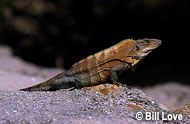Description:
Spiny-tailed iguanas look impressive with bold bands and spiny bases of their tails, so many are tempted to assume they’re just like green iguanas in temperament and behavior. Baby spiny-tailed iguanas are also bright green like green iguanas, but that color fades quickly as they grow. Nervous and flighty, they do not make very good pets as a rule. Spiny-tailed iguanas spend more time on the ground than in trees, though they are excellent climbers when the need arises. Young spiny-tailed iguanas also stay up off the ground more, probably to avoid being eaten by larger specimens. Small ones are largely insectivorous, but vegetative matter makes up an increasingly significant portion of their diets as maturity approaches. Homeowners in Florida complain that they eat the flowers and new leaves off hibiscus and other décor plants in their yards. Burrows are home for spiny-tailed iguanas, so a large cage with an underground refuge will keep them happiest. They are day-active only, and spend long hours soaking up the sun to reach the toasty warm body temperature they prefer. Don’t acquire one of these iguanas if frequent handling is your goal. Most spiny-tailed iguanas remain nervous, biting viciously and lashing with their tails at whatever annoys them. They can calm down with diligent effort and abundant food, but most new owners forsake the effort before results can be seen. The majority of spiny-tailed iguanas in the pet trade come from the wild, thus their wild behaviors.
Habitat:
Forests to fields they are habitat generalists
Range:
Central America, and now established in parts of Florida
Scientific Name: Ctenosaura similis
Species Group: iguana
Family: Iguanidae
Size: To 4 feet, though most max out at closer to 3 feet
Level: advanced
Weight:
Dangerous: No


